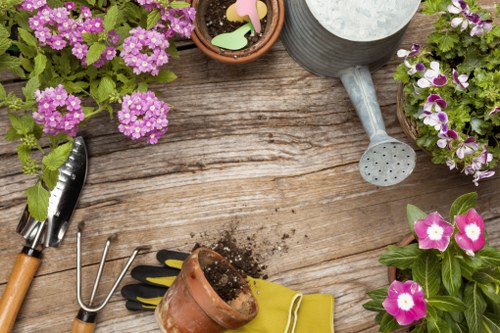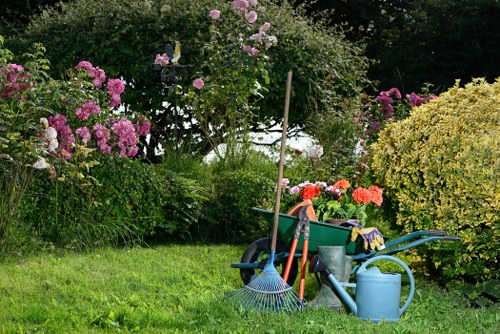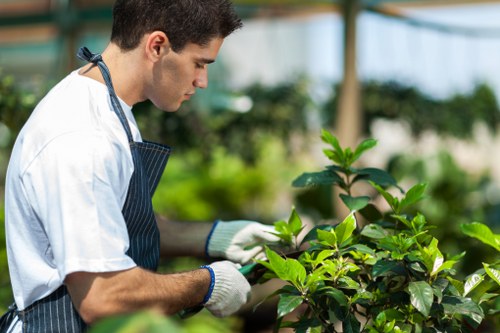Essential Garden Maintenance Tips for Notting Hill Residents

Introduction to Garden Maintenance in Notting Hill
Living in Notting Hill offers a unique blend of vibrant community spirit and picturesque gardens. Whether you’re a seasoned gardener or a novice, maintaining your garden in this charming London neighborhood can enhance your home’s appeal and provide a serene retreat from the bustling city life.
Proper garden maintenance not only boosts your property’s value but also contributes to the overall environmental health of the area. In this guide, we’ll explore essential tips and strategies tailored specifically for garden enthusiasts in Notting Hill.
From selecting the right plants to seasonal care routines, our comprehensive overview will help you achieve a lush and thriving garden all year round.

Understanding the Notting Hill Climate
Notting Hill enjoys a temperate maritime climate, characterized by mild winters and cool summers. This climate is ideal for a wide variety of plants, but understanding the specific weather patterns can help you make informed decisions about your garden maintenance.
Rainfall is relatively evenly distributed throughout the year, ensuring that your garden receives consistent moisture. However, occasional dry spells may require supplemental watering to keep your plants healthy.
Wind can also be a factor, particularly in open garden spaces. Choosing wind-resistant plants and providing adequate support can minimize damage and promote growth.

Choosing the Right Plants for Your Notting Hill Garden
Selecting plants that thrive in the local climate is crucial for a successful garden. Consider incorporating a mix of perennials, annuals, and native species to create a diverse and resilient landscape.
Perennials
Perennials come back year after year, reducing the need for replanting and ensuring continuous greenery. Popular choices include lavender, hostas, and peonies, which offer both beauty and durability.
Annuals
Annuals provide vibrant seasonal color and can be swapped out to keep your garden looking fresh. Marigolds, petunias, and impatiens are excellent options for adding splashes of color.
Native Plants
Incorporating native plants supports local ecosystems and attracts beneficial wildlife like bees and butterflies. Consider planting native fuchsias, holly, and ivy to enhance your garden’s biodiversity.
Seasonal Planting Tips
Understanding the best times to plant various species can optimize growth and flowering. Spring and autumn are ideal for planting most types of flora, while summer may require extra care to manage heat stress.
Soil Preparation
Healthy soil is the foundation of a thriving garden. Test your soil’s pH levels and nutrient content, and amend it with compost or organic matter as needed to create an optimal growing environment.
- Test soil pH and nutrient levels
- Add compost to enrich the soil
- Ensure proper drainage to prevent root rot

Regular Maintenance Practices
Maintaining your garden requires consistent effort and attention to detail. Implementing a regular maintenance routine can help prevent common issues and keep your garden looking its best.
Weeding and Mulching
Keeping weeds at bay is essential for reducing competition for nutrients and water. Regular weeding, combined with mulching, can suppress weed growth and retain soil moisture.
- Remove weeds by hand or with appropriate tools
- Apply a layer of mulch around plants to conserve moisture
- Replenish mulch as needed to maintain its effectiveness
Pruning and Trimming
Pruning helps maintain the shape and health of your plants. Regular trimming encourages vigorous growth and removes dead or diseased branches.
Tools of the Trade
Investing in quality gardening tools can make maintenance tasks easier and more efficient. Essential tools include sharp pruners, shears, a sturdy rake, and a reliable watering system.
Watering Techniques
Proper watering is crucial for plant health. Water deeply and infrequently to encourage deep root growth, and adjust your watering schedule based on seasonal changes and rainfall patterns.
Tip: Early morning is the best time to water your garden, reducing evaporation and allowing plants to absorb moisture throughout the day.
Seasonal Garden Care in Notting Hill
Different seasons bring unique challenges and opportunities for garden maintenance. Adapting your care routine to each season ensures that your garden remains healthy and vibrant all year round.
Spring Maintenance
Spring is the time to prepare your garden for the growing season. Start by clearing any winter debris and assessing the condition of your plants.
- Clean up fallen leaves and branches
- Apply fertilizer to promote new growth
- Plant spring annuals and perennials
Summer Care
Summer requires vigilant watering and pest management to cope with the heat and increased insect activity.
Managing Pests
Use natural pest control methods, such as introducing beneficial insects or applying organic treatments, to keep pests under control without harming your garden.
Heat Stress Prevention
Provide shade for sensitive plants during the hottest parts of the day and ensure consistent watering to prevent dehydration.
Autumn Preparation
Autumn is ideal for planting bulbs and preparing your garden for the winter months. Focus on planting hardy species that will thrive in cooler temperatures.
- Plant spring-flowering bulbs like tulips and daffodils
- Protect perennials by adding mulch
- Prune back dead growth to encourage healthy regrowth
Winter Protection
During winter, protect your garden by covering delicate plants and maintaining your tools. This ensures that your garden is ready to flourish when spring arrives.
Tool Maintenance
Clean and store your gardening tools properly to prevent rust and damage. Sharpen blades and oil metal parts to extend their lifespan.
Hiring Professional Garden Maintenance Services in Notting Hill
While DIY garden maintenance can be fulfilling, sometimes enlisting the help of professionals is the best choice. Professional garden maintenance services in Notting Hill offer expertise and efficiency, ensuring your garden remains in pristine condition.
Experts can provide tailored maintenance plans, addressing specific needs such as soil health, plant selection, and pest management. Additionally, professional services save you time and effort, allowing you to enjoy your garden without the stress of upkeep.
Benefits of Professional Services
- Expert knowledge of local climate and plant varieties
- Access to specialized tools and equipment
- Consistent and reliable maintenance schedules
Choosing the Right Service Provider
When selecting a garden maintenance service, consider their experience, range of services, and customer reviews. Ensure they understand your vision for your garden and can deliver results that align with your expectations.
Cost Considerations
While professional services come at a cost, the investment can lead to a more beautiful and well-maintained garden. Compare quotes and service packages to find a provider that fits your budget and requirements.
Action: Contact us today to schedule a consultation with our expert garden maintenance team in Notting Hill.Eco-Friendly Garden Maintenance Practices
Adopting eco-friendly practices in your garden not only benefits the environment but also promotes a healthier and more sustainable space. Here are some strategies to make your garden maintenance more environmentally conscious.
Composting
Composting organic waste reduces landfill burden and provides rich nutrients for your garden. Start a compost bin to recycle kitchen scraps and garden trimmings into valuable fertilizer.
- Set up a compost bin in a shaded area
- Add a mix of green and brown materials
- Turn the compost regularly to speed up decomposition
Water Conservation
Implementing water-saving techniques helps preserve this vital resource. Use rain barrels to collect rainwater and install drip irrigation systems to deliver water directly to plant roots.
Rainwater Harvesting
Rainwater harvesting is an effective way to supplement your garden’s water supply. Redirect gutters to rain barrels and use the collected water for irrigating your plants.
Drip Irrigation Systems
Drip irrigation delivers water efficiently, minimizing evaporation and runoff. This method ensures that each plant receives the right amount of moisture without waste.
Natural Pest Control
Avoid harmful chemicals by using natural pest control methods. Encourage beneficial insects, such as ladybugs and spiders, to keep pest populations in check.
- Introduce predatory insects to your garden
- Use neem oil or insecticidal soap for organic pest management
- Plant pest-resistant varieties to naturally deter unwanted visitors
Companion Planting
Companion planting involves growing certain plants together to naturally repel pests and promote growth. For example, planting basil alongside tomatoes can enhance flavor and deter insects.
Enhancing Garden Aesthetics
Aesthetics play a significant role in garden maintenance. Creating a visually appealing garden involves strategic planning and creative design.
Pathways and Hardscaping
Incorporating pathways and hardscaping elements adds structure and interest to your garden. Materials like gravel, stone, and wood can be used to create beautiful and functional outdoor spaces.
Creating Pathways
Pathways guide visitors through your garden and highlight key features. Design winding paths using natural materials to complement the surrounding flora.
Garden Structures
Adding structures such as pergolas, arbors, and garden benches provides focal points and areas for relaxation. These elements enhance the overall design and usability of your garden.
Lighting
Proper lighting extends your garden’s usability into the evening hours and highlights its features. Use solar-powered lights, lanterns, and string lights to create a magical ambiance.
- Install pathway lights for safety and aesthetics
- Use spotlights to emphasize focal plants
- Incorporate fairy lights for a whimsical touch
Maximizing Small Garden Spaces
Notting Hill’s charming residences often come with limited garden space. However, with smart design and maintenance strategies, you can maximize even the smallest gardens.
Vertical Gardening
Vertical gardening utilizes wall space to grow plants, saving ground area for other uses. Install trellises, shelves, or vertical planters to create a lush, green display.
- Use hanging pots for flowers and herbs
- Install wall-mounted planters for vegetables
- Create living walls with a variety of plant species
Container Gardening
Containers offer flexibility and control over your garden’s layout. Choose a variety of pots and planters to grow flowers, vegetables, and herbs in confined spaces.
Choosing the Right Containers
Select containers that complement your garden’s aesthetic and provide adequate drainage. Consider materials like ceramic, terracotta, and plastic based on your needs and preferences.
Space-Saving Techniques
Use multi-tiered stands and stackable planters to increase your planting area without overcrowding. These techniques allow for more greenery in limited spaces.
Smart Plant Selection
Opt for compact and dwarf plant varieties that thrive in smaller spaces. Plants like compact roses, dwarf fruit trees, and petite vegetables are ideal for maximizing limited garden areas.
Maintaining Garden Health
A healthy garden is a happy garden. Regular monitoring and proactive care prevent issues and promote robust plant growth.
Soil Health
Maintaining healthy soil is fundamental to garden maintenance. Regularly test soil quality and amend it to ensure it remains fertile and well-draining.
- Add organic matter to improve soil structure
- Use cover crops to prevent erosion and enhance fertility
- Rotate crops to reduce soil depletion and pest buildup
Fertilization
Providing the right nutrients supports plant growth and resilience. Use balanced fertilizers tailored to your plants’ specific needs, and apply them according to the recommended schedule.
Organic Fertilizers
Organic fertilizers, such as compost and manure, enrich the soil naturally without harmful chemicals. They improve soil health and support sustainable gardening practices.
Pest and Disease Management
Early detection and treatment of pests and diseases are crucial for maintaining garden health. Inspect your plants regularly and take immediate action if you notice any signs of trouble.
Pruning and Deadheading
Regular pruning and deadheading encourage continuous blooming and prevent overcrowding. Remove spent flowers and trim back excessive growth to keep your plants thriving.
Discover more tips by contacting our gardening experts today and ensure your Notting Hill garden remains vibrant and healthy.Conclusion: Enjoying Your Well-Maintained Garden
Maintaining a garden in Notting Hill is a rewarding endeavor that enhances your living space and contributes to the neighborhood’s beauty. By following these essential garden maintenance tips, you can cultivate a thriving and picturesque garden that you’ll be proud of.
Remember to consider the local climate, choose the right plants, implement regular maintenance practices, and adopt eco-friendly techniques to ensure your garden remains healthy and sustainable.
Whether you prefer a colorful floral display, a serene green space, or a practical vegetable garden, the vibrant community of Notting Hill offers endless possibilities for garden enthusiasts.
Take the next step and book your garden maintenance service now to transform your outdoor space into a stunning oasis.
